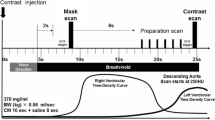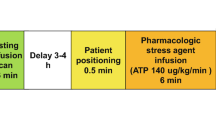Abstract
We performed this study to compare the sensitivity and specificity of multi-slice computed tomography (MSCT) to coronary angiography (CA) in detecting coronary total occlusion (CTO) lesion characteristics. Moreover, we analyzed the association between these characteristics and the risk of revascularization failure. Fifty patients with confirmed CTO diagnosis were tried for revascularization using the antegrade (all 50) or retrograde (in failed nine antegrade interventions) approaches. Each patient underwent CA and MSCT before the intervention and data from both modalities were compared using the SPSS software. Successful revascularization occurred in 36 (72%) and 6 (66.7%) patients of the antegrade and retrograde groups, respectively. Compared to CA, MSCT exhibited high sensitivity in detecting CTO segment calcification (100%), size of the affected vessel (100%, area under the curve [AUC] = 0.82), distal filling of the affected segment (97.7%) and side-branching at the CTO segment (93.3%). However, it had lower sensitivity in detecting collaterals (75%) and the length of the affected segment (87.5%, AUC = 0.77). According to MSCT data, increased occlusion length > 18 mm (p = 0.01), atherosclerotic vessel wall (p = 0.02), small distal vessel size ≤ 2.75 mm (p = 0.002), proximal side-branching (p = 0.01) and calcification of the proximal cap (p = 0.007) or distal stump (p = 0.01) were associated with an increased risk of revascularization failure. MSCT exhibited high sensitivity in identifying several CTO lesion characteristics, such as lesional calcification and size of the affected vessel. However, further research is needed to improve the diagnostic accuracy of this modality and define the predictors of revascularization failure in CTO patients.


Similar content being viewed by others
Abbreviations
- CA:
-
Coronary (conventional) angiography
- CTA:
-
Computed tomography angiography
- CTO:
-
Chronic total occlusion
- MSCT:
-
Multi-slice computed tomography
- PCI:
-
Percutaneous coronary intervention
References
Stone GW, Reifart NJ, Moussa I et al (2005) Percutaneous recanalization of chronically occluded coronary arteries: a consensus document: part II. Circulation 112:2530–2537
Bardají A, Rodriguez-lópez J, Torres-sánchez M (2014) Chronic total occlusion: to treat or not to treat? World J Cardiol 6:621–629
Joyal D, Afilalo J (2010) Interventional cardiology effectiveness of recanalization of chronic total occlusions: a systematic review and meta-analysis. Am Heart J 160:179–187
Gao L, Wang Y, Liu Y, Cao F, Chen Y (2017) Long-term clinical outcomes of successful revascularization with drug-eluting stents for chronic total occlusions: a systematic review and meta-analysis. Catheter Cardiovasc Interv 89:574–581
Elias J, Van Dongen IM, Hoebers LP, Ouweneel DM, Claessen BEPM., Råmunddal T, Laanmets P, Eriksen E, Van Der Schaaf RJ, Ioanes D, Nijveldt R, Tijssen JG, Hirsch A, Henriques JPS (2017) Improved recovery of regional left ventricular function after PCI of chronic total occlusion in STEMI patients: a cardiovascular magnetic resonance study of the randomized controlled EXPLORE trial. J Cardiovasc Magn Reson 19:53
Rathore S, Katoh O, Matsuo H et al (2009) Retrograde percutaneous recanalization of chronic total occlusion of the coronary arteries: procedural outcomes and predictors of success in contemporary practice. Circ Cadiovasc Interv 11:108
Brilakis E, Karmpaliotis D, Minh N (2014) Advances in the management of coronary chronic total occlusions. J Cardiovasc Transl Res 7:426–436
Prasad A, Rihal CS, Lennon RJ, Wiste HJ, Singh M, Holmes DR (2007) Trends in outcomes after percutaneous coronary intervention for coronary total occlusions: a 25-year experience from the Mayo Clinic. J Am Coll Cardiol 49:1611–1618
Stone GW, Kandzari DE, Mehran R, Colombo A, Schwartz RS, Bailey S, Moussa I, Teirstein PS, Dangas G, Baim DS (2005) Percutaneous recanalization of chronically occluded coronary arteries: a consensus document: part I. Circulation 112:2364–2372
Dash D (2016) Complications encountered in coronary chronic total occlusion intervention: prevention and bailout. Indian Heart J 68:737–746
Schuetz GM, Zacharopoulou NM, Schlattmann P et al (2010) Meta-analysis: noninvasive coronary angiography using computed tomography versus magnetic resonance imaging. Ann Int Med 152:167–177
Bardo DME, Brown P (2008) Cardiac multidetector computed tomography: basic physics of image acquisition and clinical applications. Curr Cardiol Rev 4:231
Kagadis GC (2005) CT of the heart: principles and applications. Med Phys 32:1453
Fujino A, Otsuji S, Hasegawa K, Arita T, Takiuchi S, Fujii K, Yabuki M, Ibuki M, Nagayama S, Ishibuchi K, Kashiyama T, Ishii R, Tamaru H, Yamamoto W, Hara M, Higashino Y (2017) Accuracy of J-CTO score derived from computed tomography versus angiography to predict successful percutaneous coronary intervention. JACC Cardiovasc Imag 11:209–217
Helge R, Rolf A, Werner GS, Schuhba A, Hamm CW, Achenbach S (2013) Preprocedural coronary CT angiography significantly improves success rates of PCI for chronic total occlusion. Int J Cadiovasc Imag 29:1819–1827
Li Y, Xu N, Zhang J et al (2015) Procedural success of CTO recanalization: comparison of the J-CTO score determined by coronary CTangiography to invasive angiography. J Cardiovasc Comput Tomogr 9:578–584
Yu C, Lee H, Suh J (2017) Coronary computed tomography angiography predicts guidewire crossing and success of percutaneous intervention for chronic total occlusion korean multicenter CTO CT registry score as a tool for assessing. Circ Cardiovasc Imag 10:e005800
Opolski MP, Knaapen P, Witkowski A, Min JK (2017) Coronary computed tomography angiography to predict successful percutaneous coronary intervention for chronic total occlusion. JACC Cardiovasc Imag 10:1206–1208
Dash D (2018) Coronary chronic total occlusion intervention: a pathophysiological perspective. Indian Heart J. https://doi.org/10.1016/j.ihj.2018.01.021
Gopakumar KS, Iype M, Viswanathan S, Koshy AG, Gupta PN, Sivaprasad K, Radhakrishnan VV (2017) Angiographic predictors of success in antegrade approach of chronic total occlusion interventions in a South Indian population in the contemporary era. Indian Heart J. https://doi.org/10.1016/j.ihj.2017.09.002
de Feyter PJ, Serruys PW, Davies MJ, Richardson P, Lubsen J, Oliver MF (1991) Quantitative coronary angiography to measure progression and regression of coronary atherosclerosis: value, limitations, and implications for clinical trials. Circulation 84:412–423
Li P, Gai L, Yang X, Sun Z, Jin Q (2010) Computed tomography angiography-guided percutaneous coronary intervention in chronic total occlusion. J Zhejiang Univ Sci B 11:568–574
Hildick-Smith DJR, Lowe MD, Walsh JT, Ludman PF, Stephens NG, Schofield PM, Stone DL, Shapiro LM, Petch MC (1998) Coronary angiography from the radial artery—experience, complications and limitations. Int J Cardiol 64:231–239
Magro M, Schultz C, Simsek C, Garcia-Garcia HM, Regar E, Nieman K, Mollet N, Serruys PW, van Geuns RJ (2010) Computed tomography as a tool for percutaneous coronary intervention of chronic total occlusions. EuroInterv J Eur Collab Work Gr Interv Cardiol Eur Soc Cardiol 6:G123–G131
Leber AW, Knez A, von Ziegler F et al (2005) Quantification of obstructive and nonobstructive coronary lesions by 64-slice computed tomography: a comparative study with quantitative coronary angiography and intravascular ultrasound. J Am Coll Cardiol 46:147–154
Choi J-H, Bin Song Y, Hahn J-Y, Choi SH, Gwon H-C, Cho JR, Jang Y, Choe Y (2011) Three-dimensional quantitative volumetry of chronic total occlusion plaque using coronary multidetector computed tomography. Circ J 75:366–375
Mollet NR, Hoye A, Lemos PA, Cademartiri F, Sianos G, McFadden EP, Krestin GP, Serruys PW, de Feyter PJ (2005) Value of preprocedure multislice computed tomographic coronary angiography to predict the outcome of percutaneous recanalization of chronic total occlusions. Am J Cardiol 95:240–243
Martín-Yuste V, Barros A, Leta R, Ferreira I, Brugaletta S, Pujadas S, Carreras F, Pons G, Cinca J, Sabate M (2012) Factors determining success in percutaneous revascularization of chronic total coronary occlusion: multidetector computed tomography analysis. Rev Española Cardiol (English Ed) 65:334–340
Acknowledgements
The authors would like to acknowledge the Medical and Teaching staff at Al-Azhar Faculty of Medicine and Kobri El-Kobba Military hospital for their support during conducting the study. Preliminary data from this study were presented at the 13th Annual Complex Cardiovascular Catheter Therapeutics, Florida (USA), 2017.
Author information
Authors and Affiliations
Corresponding author
Ethics declarations
Conflict of interest
The authors declare that they have no conflict of interest.
Electronic supplementary material
Below is the link to the electronic supplementary material.
Rights and permissions
About this article
Cite this article
Abdelmoneim, I., Sadek, A., Mosaad, M.A. et al. Diagnostic accuracy of multi-slice computed tomography in identifying lesion characteristics in coronary total occlusion. Int J Cardiovasc Imaging 34, 1813–1818 (2018). https://doi.org/10.1007/s10554-018-1392-3
Received:
Accepted:
Published:
Issue Date:
DOI: https://doi.org/10.1007/s10554-018-1392-3




